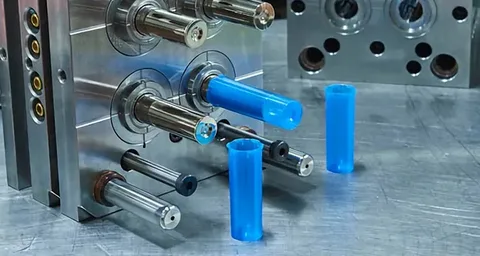Exploring the Different Parts of CNC Machines and Their Importance

Computer Numerical Control (CNC) machines have revolutionized the manufacturing industry, enabling precise, automated operations in various sectors such as aerospace, automotive, and electronics. These machines rely on various components that work together to achieve high accuracy and efficiency in machining tasks. Understanding the different parts of CNC machines and their functions is crucial for anyone involved in machine operation, maintenance, or design. In this article, we will explore the essential parts of CNC machines and the importance of each component in ensuring smooth, precise operations.
CNC Machine Frame: The Backbone of Stability
The CNC machine frame is one of the most critical components, providing the structure that holds all other parts in place. Typically made from materials like cast iron, steel, or composite materials, the frame is designed to withstand vibrations and mechanical stresses during machining operations. The rigidity and strength of the frame are essential for maintaining the accuracy and precision of the machine.
The frame not only provides the necessary stability but also serves as the foundation for other components such as the spindle, motor, and tool holder. If the frame is weak or improperly designed, it can lead to vibrations or misalignment, ultimately affecting the quality of the finished product. In high-precision applications, even the smallest deviation caused by an unstable frame can lead to significant errors in the final output.
Spindle: The Heart of Material Removal
The spindle is one of the most important parts of a CNC machine. It is responsible for rotating the cutting tool at high speeds to remove material from the workpiece. The spindle’s motor powers this rotation, while the bearings inside it ensure smooth and precise motion. The cutting tool is mounted on the spindle, and its ability to rotate at high speeds is crucial for efficient material removal.
There are different types of spindles, including vertical and horizontal spindles, each suited for specific types of machining tasks. Vertical spindles are commonly used in milling applications, while horizontal spindles are typically used for operations requiring high torque. A high-quality spindle is essential for achieving a smooth surface finish and for the overall performance of the CNC machine. If the spindle malfunctions or experiences excessive wear, it can result in poor cutting performance and a reduction in machining accuracy.
CNC Machine Controller: The Brain of the Operation
The CNC machine controller is the "brain" that interprets the programmed instructions and converts them into signals that control the movements of various machine components. It processes the G-code (a programming language used to control CNC machines) and sends commands to the motors and other parts of the machine. The controller ensures that the machine follows the exact path specified in the program, allowing for intricate and complex machining tasks.
The controller is typically integrated with a user interface, allowing operators to input commands, monitor machine performance, and adjust settings in real-time. With advancements in technology, modern CNC machine controllers are equipped with advanced features such as touchscreens, network connectivity, and enhanced diagnostic capabilities. The controller’s reliability is paramount, as any errors in its operation can result in machine malfunctions, wasted material, and compromised quality.
Linear Guides and Bearings: Precision in Motion
Linear guides and bearings are essential for the smooth, precise movement of the CNC machine's axes. These parts ensure that the machine’s table, tool holder, and other components move with high accuracy along the desired path. Linear guides provide support for the motion of the carriage and prevent any misalignment during the cutting process. Bearings help reduce friction between moving parts, enabling smoother, faster, and more accurate movement.
The importance of linear guides and bearings cannot be overstated, as they directly impact the precision and speed of the CNC machine. If these components are worn or improperly maintained, they can lead to inaccurate positioning, uneven cutting, and reduced performance. Regular inspection and lubrication of linear guides and bearings are essential to maintaining the machine’s overall accuracy and lifespan.
Tool Holder and Cutting Tools: Key to Efficient Machining
The tool holder and cutting tools are integral to the machining process, determining the type of operation performed and the material removal rate. The tool holder securely clamps the cutting tool in place, ensuring it stays fixed during the machining process. There are various types of tool holders, including collets, chucks, and quick-change systems, each designed for specific applications.
Cutting tools are designed with various geometries and materials to suit different types of machining operations, such as turning, milling, drilling, and grinding. The tool’s material, shape, and coating significantly impact the machining process, influencing factors like cutting speed, tool life, and surface finish. Proper selection and maintenance of the tool holder and cutting tools are crucial for achieving the desired quality and efficiency in machining operations. Worn-out tools can lead to poor surface finishes, increased tool wear, and even damage to the workpiece or the CNC machine itself.
Conclusion
CNC machines are complex systems with multiple components working in tandem to deliver precision and efficiency in manufacturing operations. The parts of a CNC machine, such as the frame, spindle, controller, linear guides, and tool holders, each play a critical role in ensuring smooth and accurate machining. Regular maintenance and careful attention to these components are essential for maximizing machine performance and prolonging its lifespan. By understanding the importance of each part, operators and engineers can optimize their CNC machines for better productivity, quality, and reliability.
- Art
- Causes
- Crafts
- Dance
- Drinks
- Film
- Fitness
- Food
- Games
- Gardening
- Health
- Home
- Literature
- Music
- Networking
- Other
- Party
- Religion
- Shopping
- Sports
- Theater
- Wellness


